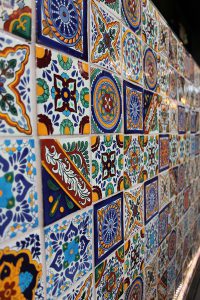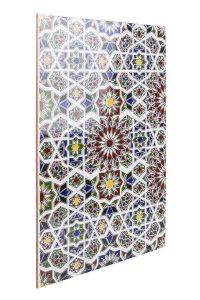 In most cases, the tiles are made of a mineral material, which is kaolin. The material is preformed into the required shape and then the tiles are fired in an oven. As a rule, this is a temperature between 1000 and 1100 degrees. The raw material of glazing ceramics has quite high water absorption, up to 10%, in order to reduce water absorption the tile must be glazed and fired again.
In most cases, the tiles are made of a mineral material, which is kaolin. The material is preformed into the required shape and then the tiles are fired in an oven. As a rule, this is a temperature between 1000 and 1100 degrees. The raw material of glazing ceramics has quite high water absorption, up to 10%, in order to reduce water absorption the tile must be glazed and fired again.
Glaze is a lightweight material. Its disadvantage, however, is that the tiles are very fragile and every time they are processed, which involves cutting and cutting tiles there is a risk of cracking, so special attention should be paid to mechanical processing of the glaze.
The method of tiling, and especially its joining, is possible by cutting the tile edges to 45 degrees or using special finishing strips. Such slats are most often used when a person applying tiles to the wall cannot show too much experience with such actions.
Due to their characteristics, glazed tiles are mainly suitable for indoor use.
A terracotta is also a kind of tile, but it differs in the material from which it is made. Most often it is a composition of stoneware with various additions, such as quartz sand or chamotte.
Terracotta tiles have completely different characteristics than glazed tiles. Terracotta is much heavier than glazed tiles. The structure of terracotta tiles is more compact. Terracotta tiles are also fired at a much higher temperature than glazed tiles, the firing temperature reaches up to 1300 degrees C. The production process itself is very similar and, as in the case of glaze, consists of forming and firing raw material, after which the tile is coloured and/or glazed and fired again.
The water absorption of the terracotta is much lower than in the case of glaze, so it is possible to apply these tiles on external surfaces, balconies, terraces or arbours.
Of course, depending on the project and the investor's invention, the terracotta tiles can also be laid on the wall, and the way of installing the terracotta and the glaze does not differ particularly.
The production of greser differs from the production of other tiles in that it is pressed with a pressure ranging from 800 to 1000 kg per 1 cm2, on a special press. Consequently, gres porcelain stoneware tiles are the hardest ceramic material that can be laid on the desired surface. The firing temperature of stoneware tiles is also higher than that of glaze or terracotta and reaches 1400°C. This is due to very high resistance to mechanical damage and low abrasion.
Gres tiles are also characterized by very low water absorption, which does not exceed 0.5%, so they are ideal for outdoor use, as well as in rooms with high humidity, such as bathrooms, kitchens, saunas and laundries.
There are 2 types of stoneware tiles:
- Natural stoneware
On the surface of the natural stoneware tile the structure of the material is visible in the form of grains. Natural stoneware can also be sanded, matted or high gloss. Gres porcelain stoneware tiles polished to a high gloss even imitate the stone surface perfectly.
- Glazed stoneware
The process of stoneware glazing is similar to that of glaze and terracotta, i.e. a pressed tile is fired, then tinted, glazed and re-fired.
The shape of the gres porcelain stoneware tiles depends solely on the design and press matrix. If the design provides for a fancy non-geometric shape, the investment in the matrix will ensure a unique appearance of the surface.
 More and more often designers and investors are returning to hand-made or old technology ceramic tiles. Such tiles are characterised by the fact that they are not identical, there may be deviations from dimension, as well as in the patterns and colours applied. Tiles made in this way give the room an individual character.
More and more often designers and investors are returning to hand-made or old technology ceramic tiles. Such tiles are characterised by the fact that they are not identical, there may be deviations from dimension, as well as in the patterns and colours applied. Tiles made in this way give the room an individual character.
At the moment, such ceramics are most often imported to Europe from Mexico and North Africa, Tunisia or Morocco. As far as Europe is concerned, Spain, Italy or, generally speaking, the Mediterranean countries have the greatest tradition when it comes to hand-made ceramics.
 Both glazed tiles, as well as terracotta or gres tiles, can be decorated with patterns that the artist has hand-painted and coloured in a similar way. Decorative elements in the form of patchwork tiles are becoming more and more fashionable recently. Patchwork can be applied to the surface in different patterns and different colours or shades of colour. This gives many possibilities to arrange the interior, to mark its characteristics, culture and style.
Both glazed tiles, as well as terracotta or gres tiles, can be decorated with patterns that the artist has hand-painted and coloured in a similar way. Decorative elements in the form of patchwork tiles are becoming more and more fashionable recently. Patchwork can be applied to the surface in different patterns and different colours or shades of colour. This gives many possibilities to arrange the interior, to mark its characteristics, culture and style.
The dimensions of ceramic tiles can vary from small, for example 5 x 5 cm, to large tiles imitating for example stone, 240 x 120 cm.
The surface of a room is usually finished with household ceramics for many years, which is why a well thought-out design that takes into account our taste and taste is so important.